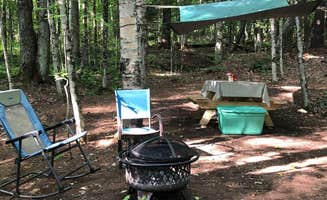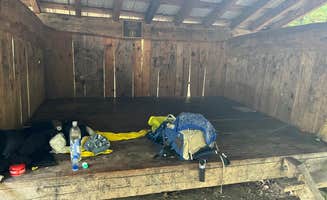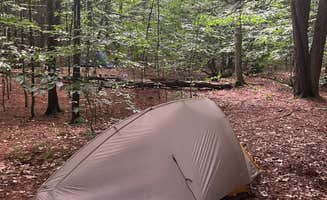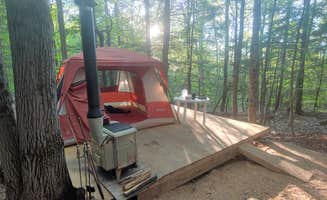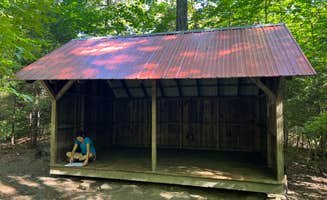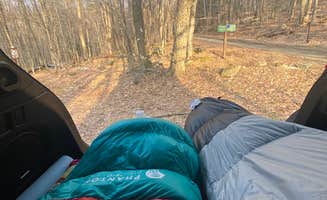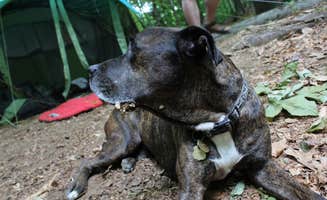Tent campsites near Newport, New Hampshire provide varied backcountry experiences within the Connecticut River Valley region. The area sits at elevations ranging from 700 to 3,000 feet with a mix of dense forest, open ridgelines, and mountain terrain. Summer temperatures typically range from 50-85°F, while spring and fall bring greater temperature fluctuations and possible overnight frost even during summer months in higher elevation sites.
What to do
Hiking Mount Cardigan: The tent camping area at Cardigan Campsites serves as an excellent base for summit attempts. "Great spot to spend the night before a climb of Mt. Cardigan! Or after! The climb is challenging but shouldn't take too long. Great fire tower views at the top too!" notes Madison G.
Bench viewpoints: Some backcountry shelters offer unique viewing areas beyond standard tent sites. At Moose Mountain Backcountry Shelter, campers enjoy a special feature: "The shelter did stand out with a bench overlooking a clearing in the brush with a view which was a great place to enjoy my freeze dried dinner."
Water activities: Many tent campers combine their overnight stays with paddling on nearby bodies of water. North Hartland Lake Beach provides tent sites with electrical hookups for those wanting to charge devices while spending days on the water, though facilities remain basic compared to developed campgrounds.
What campers like
Double-decker shelters: Some Appalachian Trail shelters offer unique sleeping arrangements. At Happy Hill Backcountry Shelter, "The shelter had a ground floor and a loft but each floor could maybe fit 4-5 people comfortably... The loft was nice since folks could decide to sleep up there while others were down below, either cooking, arriving, or departing."
Flat tent sites: Finding level ground ranks high in camper satisfaction. Winturri Backcountry Shelter receives praise for its abundance of quality tent spots: "The shelter is on the larger side and could fit maybe 6-8 folks. There were lots of tent camping spots as you worked up the hill perpendicular to the shelter... this stop had a great amount of tent camping around in spaces with decent privacy."
Upgraded facilities: Newer privy facilities make a significant difference in backcountry camping satisfaction. Justin P. noted at Moose Mountain: "The privvy was also new and very spacious," indicating the infrastructure improvements that periodically occur along the trail system.
What you should know
Water reliability: Water sources at tent sites near Newport vary seasonally and by location. At Thistle Hill Backcountry Shelter, one camper reported: "There was a decent privvy and water during my stay, though it was right after a smaller storm the previous evening," highlighting the unreliable nature of water sources.
Terrain challenges: Not all tent sites offer ideal flat ground. Justin P. noted at Thistle Hill: "it seemed to have smaller spots for tent camping that were somewhat sloped," a common consideration when selecting where to pitch tents in this region.
Glamp tent upgrades: Some locations have improved their offerings over time. At Lost Boys Hideout, a camper reported: "Nice new tents provided at Sleepy Hollow site. Improvements to the firepit, area all mulched, even some games and water are provided!" This shows the evolving nature of some camping areas.
Tips for camping with families
Shelter alternatives: When camping with children, tenting near shelters provides more privacy while maintaining access to facilities. At Happy Hill Backcountry Shelter, "There were a bunch of level tent camp sites around the shelter," allowing families to maintain their own space.
Campground staff interactions: Staff quality varies between locations. At Cardigan Skyline Camps, which offers just two tent sites, the intimacy of the location means more interaction with staff. As one camper at nearby Cardigan Campsites noted, "Staff is very friendly," indicating the personal attention that can enhance family camping experiences.
Walk-in considerations: Many tent sites require at least short walks from parking areas. Families should note that Lost Boys Hideout requires walk-in or hike-in access, which means additional planning for carrying children's gear and supplies to your campsite.
Tips from RVers
RV-tent combinations: While primarily tent-focused, some locations accommodate both RVs and tents. Winturri Backcountry Shelter lists RVs among accommodation types despite its backcountry nature, suggesting some flexibility in vehicle access points or defined camping areas that might work for smaller RVs or vans.
Electrical needs: Tent campers with electrical requirements should note North Hartland Lake Beach offers electric hookups, though without many other amenities, making it suitable for tent campers who need to power devices while maintaining a more primitive camping experience.
Site limitations: Most tent sites in the region have minimal to no vehicle access, with true backcountry locations requiring significant hiking with gear. The majority of Appalachian Trail tent sites cannot accommodate any vehicles beyond the trailhead parking areas, which are often miles from the actual camping locations.


